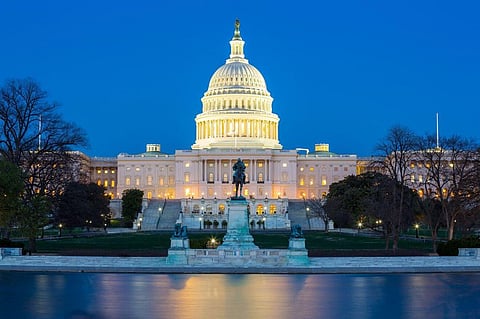
- Home
- न्यूजग्राम
- NewsGram USA
- India
- World
- Politics
- Entertainment
- Culture
- Lifestyle
- Economy
- Sports
- Sp. Coverage
- Misc.
- NewsGram Exclusive
- Jobs / Internships

BY NATHAN HOLT
The recent US elections captured the attention of the whole world. Departing President Donald Trump was perhaps the most divisive leader that the country ever had. It is hoped that his replacement, Joe Biden, will begin to heal the wounds that have disfigured the body politic in recent years.
Commentators have lamented the increasing partisanship of US politics. America is essentially a two-party state. In the past, the Republicans and the Democrats have been able to find common ground and cooperate on critical issues. The last decade has seen them become ever-more entrenched in seemingly irreconcilable ideological positions.
Surprisingly, the most divisive issue is one that urgently requires cross-party support and which impartial observers say should be above issues of party politics. This is the issue of the environment and climate change. But while Biden's party, the Democrats, has become ever-more insistent on the need for environmental protection and decisive action to tackle climate change, the Republicans have become more determined to resist such moves and even deny or downplay the evidence of climate change altogether.
Follow NewsGram on Facebook to stay updated.
Public support
Such partisanship is even more frustrating because of the widespread support for environmental protection among the American people. A 2020 survey showed that two-thirds ranked protecting the environment as a leading priority. The same study highlighted the party split, with 78% of Democrat supporters being pro-environment than less than 25% of Republicans.
The poll revealed that climate change was the #1 divisive issue, closely followed by environmental protection. Subjects traditionally the source of ideological disagreements, like guns, military spending, immigration, and education, actually enjoyed more common ground between the parties.
America is essentially a two-party state. Flickr
The problems of partisanship
When one party flatly opposes the other's proposals, this can lead to gridlock, where nothing gets done. That is especially the case if the president's party doesn't have a majority in congress, as was the case for much of Barack Obama's administration. While Trump had more support in the house, the acts he passed caused intense resentment among the opposition.
Many of the laws passed by the Democrats were repealed by the Republicans, including over 100 environmental regulations. Biden now has the opportunity to restore those, but if they are repealed again by a future Republican president, then the whole circus starts to seem like a pointless game. This, in turn, leads to disillusionment with mainstream politics among voters, something that can generate both extremism and apathy.
Changing the game
The cross-party campaign group No Labels has long sought to break down the barriers between the two sides of the house, overcoming bipartisanship so that decisive action can be taken on crucial issues. They've had many successes and are hopeful that breaking the deadlock on the environment will be the next step.
The US Senate is currently split between 50 Republicans and 48 Democrats, plus two Democrat-friendly independent senators. That effectively means a 50-50 split, but Democrat Vice-President Kamala Harris would have the deciding vote, meaning that the Democrats control the Senate. They also maintain a majority in the House of Representatives, though at 221 to 211, with three vacant seats, it is smaller than previously.
Joe Biden. Wikimedia commons
How it got this way
Partisanship has increased massively in the last decade or so, but of course, the two parties have always held differing positions on many issues. However, the environment was not always one of these. Indeed, when ecology and natural preservation first became a mainstay of the political agenda, back in the late 1960s, they were very much seen as enjoying cross-party support. The Republicans were responsible for groundbreaking legislation on clean air and water, while President Nixon created the Environmental Protection Agency in December 1970.
However, during the Reagan administration of the 1980s, Republicans began to see Federal intervention as unwelcome generally. The environment was considered to be one of the areas where free-market economics would solve the problem. The legislation was seen as unnecessary and counter-productive. At the same time, Democrats took up the environmental cause, partly to win votes from the growing Green movement.
Coming together
The Democrat election campaign included a $2trn promise to tackle climate change. It was hugely ambitious, and skeptics have suggested that they never expected to be in a position where they would be able to act on it fully. Even with a working majority, Biden will want to pursue those areas of the environmental package that potentially enjoy bipartisan support, such as farm aid and support for renewable energy.
ALSO READ: Joe Biden Plan to Revitalize Rural America Through Investments
There is a balance to be struck between the progressive wing of the Democrat party, who will demand urgent, far-reaching action, and hearing the concerns of working-class Republican-leaning voters, who fear for their jobs in industries that are either dependent on fossil fuels or seen as environmentally unfriendly, such as the auto industry. A switch to clean energy that creates new jobs could be included in an economic stimulus and COVID-19 relief package.
Biden's track record shows he is someone who looks for common ground rather than clashes. He is a legislator who has made a career out of bringing both sides of the house together on important issues. To push the environment to the top of the agenda, it's these bipartisan instincts that he needs to nurture more than ever.
(Disclaimer: The article is sponsored and hence, includes some commercial links.)
